

The name "Alberta" is in honor of the daughter of Queen Victoria. The Province's motto is Fortis et Liber - Strong and Free.
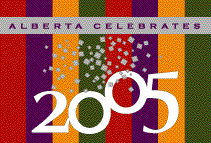
Alberta became a Province in 1905. All year, Albertans throughout the Province have been celebrating the centennial . |
|


The flag of Alberta was officially adopted in 1967.
The centered shield dates from 1907. It depicts a scene representing the vast, golden wheat fields of western Canada. Included are the green valleys and snow-covered mountains of Alberta - all set under St. George's Cross.
|
 To Top To Top
|

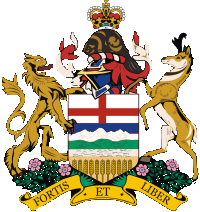
The Coat of Arms of Alberta was granted by Royal Warrant on May 30, 1907 by King Edward VII of the United Kingdom. On July 30, 1980, the Armorial Bearings (the Crest, Supporters and Motto) were added by Royal Warrant by Queen Elizabeth II.
The Coat of Arms represents the natural resources and varied beauty of Alberta landscape: the Rocky Mountains and their foothills, the grass prairies, and the cultivated wheat fields.
The shield is also featured on the Flag of Alberta.
|

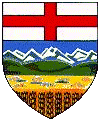
Shield of Arms
The Shield of Arms was adopted May 30th, 1907. Topped by a red St. George’s Cross on a white background, the Shield of the Arms of Alberta features azure (blue) in back of a range of snow-capped mountains with green hills, prairie and a wheat field in front.
|
 To Top To Top
|

  Provincial Colours - blue (sky) and golden yellow (prairies) Provincial Colours - blue (sky) and golden yellow (prairies)
 Stone - Petrified Wood Stone - Petrified Wood
 Mammal - Rocky Mountain Bighorn Sheep Mammal - Rocky Mountain Bighorn Sheep
 Bird - Great Horned Owl Bird - Great Horned Owl
 Fish - Bull Trout Fish - Bull Trout
 Tree - Lodgepole Pine Tree - Lodgepole Pine
 Flower - Wild Rose Flower - Wild Rose
 Grass - Rough Fescue Grass - Rough Fescue
 Tartans Tartans |
 To Top To Top
|


Provincial Colours
The Provincial Colours were adopted in 1984. The blue represents the sky and gold/deep yellow represents the prairies.
|
 Back to Emblems Back to Emblems
|

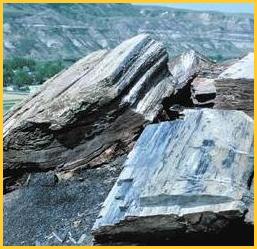
Petrified Wood
In 1977, the Legislative Assembly recognized petrified wood as the official stone of Alberta.
Petrified wood was originally formed in coal seams and later carried by water and deposited in stream and river beds and gravel pits throughout Alberta. It is a semi-precious stone used in jewelry and ornaments. The choice of petrified wood is especially appropriate because of the stone's natural beauty and it belongs to the age when oil was first formed. |
 Back to Emblems Back to Emblems
|

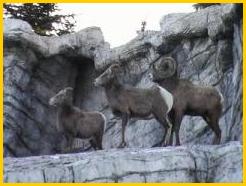
Rocky Mountain Bighorn Sheep
The Bighorn Sheep was adopted as Alberta's mammal August 18th, 1989. The Bighorn is a majestic, native Alberta animal. Prehistoric remains have been found in most of the river valleys across Alberta, showing that at one time large herds of Bighorn Sheep roamed the province. Today the Bighorn is primarily found in the Rocky Mountain region.
|
 Back to Emblems Back to Emblems
|

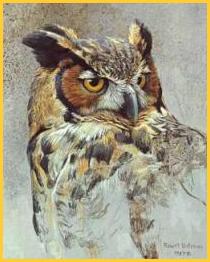
Great Horned Owl
The Great Horned Owl was adopted as Alberta's bird May 3rd, 1977, by a Province wide children's vote. The owl is a year-round resident of the province and represents the concern of Albertans for our wildlife.
|
 Back to Emblems Back to Emblems
|

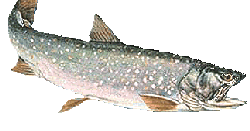
Bull Trout
The Bull Trout was adopted May 2nd, 1996 as Alberta's fish. It is one of eight species found in Alberta’s glacial fed waters, and is often confused with the brook trout, but lacks black markings on its dorsal fins.
In order to ensure Alberta’s population of bull trout never becomes endangered, there is a catch and release policy governing all bull trout fishing in the province.
|
 Back to Emblems Back to Emblems
|

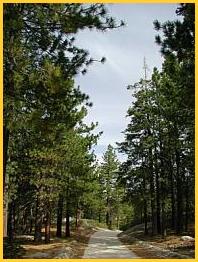
Lodgepole Pine
In the early 1900s, the lodgepole pine was primarily used to make railway ties. Today it plays a major role in Alberta’s forest industry and is manufactured into poles, posts, pulp, plywood, mine timbers and other lumber products.
The Logdepole Pine was adopted as Alberta's tree May 30, 1984 due to the efforts of the Junior Forest Warden Association of Alberta.
|
 Back to Emblems Back to Emblems
|


Wild Rose
The floral emblem was chosen by Alberta school children in 1930.
It grows not only in Alberta, but in many parts of Canada.The Wild Rose has a beautiful scent and is a pretty bright pink. The red berries that it produces are food for birds in the winter.
|
 Back to Emblems Back to Emblems
|

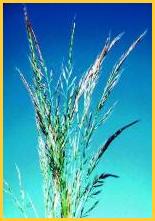
Rough Fescue
Alberta is celebrating the addition of a new provincial emblem. Rough Fescue grass was adopted on April 30th, 2003.
The addition of this new emblem was coordinated by the Prairie Conservation Forum. The Forum consulted a range of Alberta scientists and resource managers to identify five candidate grasses for Albertans to vote on through a mail-in or online ballot. Rough fescue (Festuca scabrella) was the winner selected by Albertans.
|
 Back to Emblems Back to Emblems
|


Alberta's tartan pays tribute to the Scottish component of our heritage. Tartans are plaid cloths that originated in Scotland. The colors and patterns displayed on tartans represented various clans, or families. Today, many Canadian provinces have official tartans.
|
The Work Tartan
Alberta’s official tartan was adopted on March 30, 1961 by an Act of the Legislature.
The colours represent our abundant natural resources: green for forests, gold for wheat fields, blue for lakes, pink for wild roses, and black for coal and petroleum. The official work tartan was designed by the Edmonton Rehabilitation Society for the Handicapped.
The Dress Tartan
Alberta's Dress Tartan complements the official tartan and can be worn for dancing, special occasions, and formal attire. It was adopted by Alberta in 2000 and includes the same colours as the official tartan with large sections of white, being a symbol of Alberta's clean, bright snowy days.
|
 Back to Emblems Back to Emblems
|
|
![]()
![]()
![]()